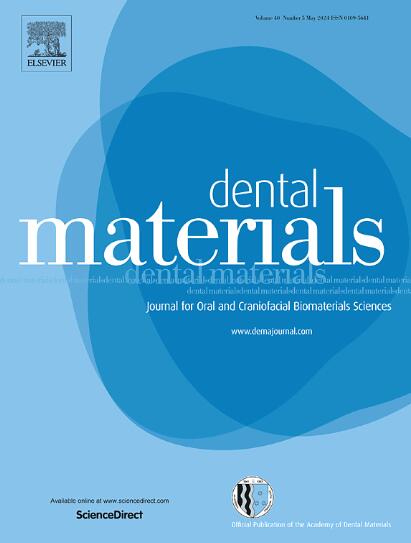评估由高活性离子玻璃和瓶玻璃混合物制成的牙科水门汀:水门汀的操作、机械、氟离子释放、不透射线和固化特性。
IF 6.3
1区 医学
Q1 DENTISTRY, ORAL SURGERY & MEDICINE
引用次数: 0
摘要
目的评估由高活性离聚体玻璃和瓶形玻璃混合物制成的牙科水门汀的机械性能、氟化物释放量、不透射线性和凝固特性:合成、研磨、筛分两个高活性玻璃系列(LG99 和 LG117),并使用 XRD 和激光粒度分析法对其进行表征。将这些玻璃与预定比例的磨碎瓶玻璃、聚丙烯酸和酒石酸水溶液混合,形成玻璃离子聚合物水门汀。对水门汀的工作时间(WT)、凝固时间(ST)、氟化物释放量、不透射线性、抗压强度(CS)和弹性模量(EM)进行了评估。采用多变量方差分析和 Tukey 后检验(p = 0.05)分析 CS 的平均差异:结果:两组的 WT 和 ST 均为 1.5 至 2.5 分钟。LG99 系列水泥的 CS(∼65 MPa)和 EM(∼2 GPa)明显高于 LG117 系列(p 27Al 魔角旋光核磁共振(MAS NMR)证实了 Al(IV)和 Al(VI)的存在,表明两个系列的水泥都在一天前完成凝固。瓶玻璃的化学位移为 55.8 ppm,与 LG99 的 Al(IV)信号重叠。19F MAS NMR 光谱显示所有玻璃中都存在 Al-F 和 F-Sr(n)物种,LG117 在去离子水中一天后形成 CaF2:高活性离聚体玻璃和瓶形玻璃的混合物制成的水门汀具有令人满意的牙科应用特性。需要进一步研究以优化其配方和性能。本文章由计算机程序翻译,如有差异,请以英文原文为准。
Evaluation of dental cements derived from mixtures of highly reactive ionomer glasses and bottle glass: Cement manipulation, mechanical, fluoride ion releasing, radiopaque and setting properties
Objectives
To evaluate the mechanical properties, fluoride release, radiopacity, and setting characteristics of dental cements derived from highly reactive ionomer glasses and bottle glass mixtures.
Methods
Two highly reactive glass series, LG99 and LG117, were synthesized, milled, sieved, and characterized using XRD and laser particle size analysis. These glasses were mixed with predetermined ratios of ground bottle glass, poly(acrylic acid), and aqueous tartaric acid to form glass ionomer cements. The cements' working time (WT), setting time (ST), fluoride release, radiopacity, compressive strength (CS), and elastic modulus (EM) were evaluated. Mean differences in CS were analyzed using multivariate ANOVA with Tukey’s post hoc test at p = 0.05.
Results
The WT and ST for both groups ranged from 1.5 to 2.5 min. LG99 series cements showed significantly higher CS (∼65 MPa) and EM (∼2 GPa) than LG117 series (p < 0.05). Both series showed similar fluoride release profiles, peaking at 1.2 mmol/L at 28 days. Radiopacity for LG99 ranged from 0.97 to 1.34, while LG117 ranged from 0.60 to 0.95. Solid state 27Al magic-angle spinning-nuclear magnetic resonance (MAS NMR) confirmed the presence of Al(IV) and Al(VI), indicating setting completion by one day for both series. Bottle glass showed a chemical shift at 55.8 ppm, overlapping with LG99′s Al(IV) signal. The 19F MAS NMR spectra revealed Al-F and F-Sr(n) species in all glasses, with LG117 forming CaF2 after one day in deionized water.
Conclusion
Mixtures of highly reactive ionomer glass and bottle glass produced cements with satisfactory properties for dental applications. Further research is needed to optimize their formulation and properties.
求助全文
通过发布文献求助,成功后即可免费获取论文全文。
去求助
来源期刊

Dental Materials
工程技术-材料科学:生物材料
CiteScore
9.80
自引率
10.00%
发文量
290
审稿时长
67 days
期刊介绍:
Dental Materials publishes original research, review articles, and short communications.
Academy of Dental Materials members click here to register for free access to Dental Materials online.
The principal aim of Dental Materials is to promote rapid communication of scientific information between academia, industry, and the dental practitioner. Original Manuscripts on clinical and laboratory research of basic and applied character which focus on the properties or performance of dental materials or the reaction of host tissues to materials are given priority publication. Other acceptable topics include application technology in clinical dentistry and dental laboratory technology.
Comprehensive reviews and editorial commentaries on pertinent subjects will be considered.
 求助内容:
求助内容: 应助结果提醒方式:
应助结果提醒方式:


